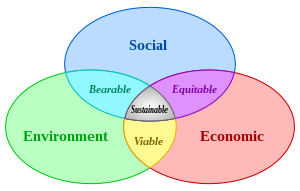
The three pillars of sustainability. Click on image areas for more information. (Photo credit: Wikipedia)
Green banking is ethical banking that is socially responsible and promotes environmental sustainability. At first glance, several banks tout their “greenness” in advertising and marketing, but upon closer inspection,it is apparent that many of these institutions limit their efforts to the provision of online services and other practices that reduce the use of paper, thereby appealing to “tree huggers” (a derogatory term for environmentalists who support restrictions on the logging industry and who fight for preservation of forests). These same banks have adopted procedures to reduce the often burdensome paper load traditionally required for many of their products, including, but not limited to, mortgages, certificates of deposits and loans, both residential and commercial.
Many financial institutions have incorporated banking with the use of mobile applications. The development and introduction of mobile apps to the smartphone market has gone a long way to provide customers access to their bank account 24 hours a day, with the ability to transfer funds between their accounts in one bank, as well as pay bills and transfer money to outside banks or individuals. It is important to note that many of these features were made available so that banks could compete with online payment and money transfer giants, such as PayPal, as well as totally online banks like Ally. These mobile banking apps often include deposit features, which allow customers to make check deposits with the use of smartphone cameras. The increased use of online banking features have resulted in a reduced carbon footprint with savings in time and transportation with fewer trips required to visit brick and mortar facilities; however, green baking encompasses so much more than this.
The essence of green banking is social responsibility, which in turn, fosters sustainability. Green banking has five major components.
- Green finance. While it is required that a bank performs credit ratings in its analysis of a proposed investment project, a green bank also will analyze the environmental risk of a potential investment, and it will reject investment in a project that would be destructive to the environment.
- Green marketing. This activity involves making the environmental benefits of the products and services sold of tantamount importance. These efforts could mandate modifications of products or the production process or changes in advertising to ensure that goods and services, as well as consumer interest, are protected.
- In house green activities. Green banks provide detailed written reports on water and energy consumption, paper use, and the use if supplies, such as ink and toner. Employees are trained in measures to efficiently use energy, equipment and supplies.
- Capacity building and research. While many banks finance activities at regular interest rates in regions and communities prone to hazardous natural events, i.e., floods, earthquakes and droughts, green banks go farther by creating Climate Change Risk Funds to be used in cases of emergency. Additionally, green banks show these expenses for emergencies under general expenses on their balance sheets.
- Corporate social responsibility. Banks are corporations and are expected to be profitable. While most, if not all financial institutions adopt some philanthropic programs, green banking mandates that such institutions carefully manage their economic, social and environmental impact, as well as their influence in “the workplace, the supply chain, the community, and the public policy realm“. [5]
Any financial institution truly committed to “green banking” will ensure that its structure includes the above-stated components. The green banking movement is gaining momentum in the global financial sector, and clearly is a win for the banks, the consumers, and the environment. It is more urgent than ever that we, the green consumers, not only demand the services that we deserve, but also that such services are delivered in line with our values of sustainability and commitment to the environment. Let’s join together to encourage and support green banking. To do so is to live green, be green.
___________________
Resources for this article:
1. http://greenbankreport.com/green-bank-deals/what-is-the-meaning-of-green-banking/
2. http://greenbankreport.com/green-bank-deals/the-future-of-green-banking-is-bright/
3. http://www.linkedin.com/groups/What-is-green-banking-in-4821165.S.208486050?_mSplash=1
4. http://www.hks.harvard.edu/m-rcbg/CSRI/init_define.html
